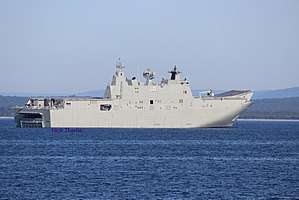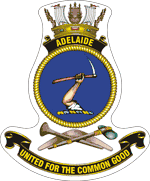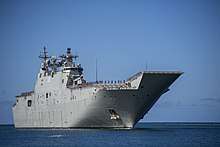HMAS Adelaide (L01)
HMAS Adelaide (L01) is the second of two Canberra-class landing helicopter dock (LHD) ships of the Royal Australian Navy (RAN). Construction of the ship started at Navantia's Spanish shipyard with steel-cutting in February 2010. The ship was laid down in February 2011, and launched on 4 July 2012. Delivery to Australia for fitting out at BAE Systems Australia's facilities in Victoria was scheduled for 2013, but did not occur until early 2014. Despite construction delays and predictions the ship was commissioned in December 2015.
 Adelaide (L01) at anchor in Jervis Bay | |
| History | |
|---|---|
| Namesake: | City of Adelaide |
| Builder: | Navantia, Ferrol, Spain and BAE Systems Australia, Williamstown, Victoria |
| Laid down: | 18 February 2011 |
| Launched: | 4 July 2012 |
| Commissioned: | 4 December 2015 |
| Homeport: | Fleet Base East |
| Identification: |
|
| Motto: | United for the common good |
| Honours and awards: | Battle honours: four inherited battle honours |
| Status: | Active as of 2016 |
| Badge: |
 |
| General characteristics | |
| Class and type: | Canberra-class Landing Helicopter Dock |
| Displacement: | 27,500 tonnes (30,300 short tons; 27,100 long tons) at full load |
| Length: | 230.82 m (757.3 ft) |
| Beam: | 32.0 m (105.0 ft) |
| Draft: | 7.08 m (23.2 ft) |
| Propulsion: |
|
| Speed: |
|
| Range: | 9,000 nautical miles (17,000 km; 10,000 mi) at 15 knots (28 km/h; 17 mph) |
| Boats & landing craft carried: | 4 × LLC |
| Capacity: |
|
| Troops: | 1,046 |
| Complement: | 358 personnel; 293 RAN, 62 Australian Army, 3 RAAF |
| Sensors and processing systems: | Giraffe AMB radar, Saab 9LV combat system |
| Electronic warfare & decoys: |
|
| Armament: |
|
| Aircraft carried: |
|
| Aviation facilities: | Flight deck with 13 degree ski-jump, 6 in-line deck landing spots |
Design
The Canberra-class design is based on the warship Juan Carlos I, built by Navantia for the Spanish Navy.[1] The contract was awarded to Navantia and Australian company Tenix Defence following a request for tender which ran from February 2004 to June 2007, beating the enlarged Mistral-class design offered by the French company Direction des Constructions Navales.[1][2][3] Adelaide has the same physical dimensions as Juan Carlos I, but differs in the design of the island superstructure and the internal layout, in order to meet Australian conditions and requirements.[4] Unlike the Spanish vessel, the Australian ships are built to meet Lloyd's Naval Rules.[4]

The Canberra-class vessels are 230.82 metres (757.3 ft) long overall, with a maximum beam of 32 metres (105 ft), and a maximum draught of 7.08 metres (23.2 ft).[5] At full load, Adelaide will displace 27,500 tonnes (27,100 long tons; 30,300 short tons), making the Canberra-class ships the largest vessels to serve in the RAN.[5] Propulsion is provided by two Navantia Siemens 11-megawatt (15,000 hp) azimuth thrusters, each with an onboard electric motor, driving two 4.5-metre (15 ft) diameter propellers.[5][6] The electricity is provided by a Combined diesel-electric and gas system, with a single General Electric LM2500 turbine producing 19,160 kilowatts (25,690 hp), supported by two Navantia MAN 16V32/40 diesel generators, each providing 7,448 kilowatts (9,988 hp).[5] Maximum speed is over 20 knots (37 km/h; 23 mph), with a maximum sustainable full-load speed of 19 knots (35 km/h; 22 mph), and an economical cruising speed of 15 knots (28 km/h; 17 mph).[5] Economical range is 9,000 nautical miles (17,000 km; 10,000 mi).[5]
Each ship is fitted with a Saab 9LV Mark 4 combat management system.[4] The sensor suite includes a Sea Giraffe 3D surveillance radar, and a Vampir NG infrared search and track system.[4] For self-defence, the LHDs will be fitted with four Rafael Typhoon 25 mm remote weapons systems (one in each corner of the flight deck),[7] six 12.7 mm machine guns, an AN/SLQ-25 Nixie towed torpedo decoy, and a Nulka missile decoy.[5] Defence against aircraft and larger targets is to be provided by escort vessels and air support from the Royal Australian Air Force (RAAF).[7] The ships' companies will consist of 358 personnel; 293 RAN, 62 Australian Army, and 3 RAAF.[8]
The LHDs will transport 1,046 soldiers and their equipment.[8] Adelaide will be capable deploying a reinforced company of up to 220 soldiers at a time by airlift.[4] Two vehicle decks (one for light vehicles, the other for heavy vehicles and tanks) have areas of 1,880 square metres (20,200 sq ft) and 1,410 square metres (15,200 sq ft) respectively, and between them can accommodate up to 110 vehicles.[5] The well deck will carry up to four LHD Landing Craft, which can be launched and recovered in conditions up to Sea State 4.[5][6] The flight deck can operate six MRH-90-size helicopters or four Chinook-size helicopters simultaneously, in conditions up to Sea State 5.[7] A mix of MRH-90 transport helicopters and S-70B Seahawk anti-submarine helicopters will be carried: up to eight can be stored in the hangar deck, and the light vehicle deck can be repurposed to fit another ten.[5][9] The ski-jump ramp of Juan Carlos I has been retained for the RAN ships, although fixed-wing flight operations are not planned for the ships.[8][10]
Construction
.jpg)
Construction of Adelaide began at Navantia's shipyard in Ferrol, northern Spain, during February 2010, when the first steel was cut.[4] Hull modules were fabricated at Ferrol and Fene, with the first hull blocks laid down on 18 February 2011.[11] Adelaide's hull was launched on 4 July 2012.[12][13] Initially, the ship was due to reach Australia in early 2013 to begin final fitout and superstructure installation at BAE Systems Australia facilities in Victoria,[8][11] but this did not occur. The hull was loaded onto Blue Marlin on 10 December 2013 in Vigo Bay.[14] Blue Marlin and Adelaide arrived at Williamstown on 7 February 2014.[15] On 17 June 2015, Adelaide departed from Williamstown to commence sea trials, which included sailing to Sydney for docking at Garden Island, before returning to Williamstown on 11 July.[16][17] A second set of trials ran from 19 to 28 August, and the ship was delivered to Fleet Base East two days later.[18][19]
Entry into RAN service was originally planned for mid-2015, but as of July 2011, this had been pushed back to sometime in 2016.[4][11] Fitting out of the ship progressed at a faster rate than expected, which brought the predicted commissioning date back to September 2015,[17] although this did not eventuate. The ship was formally handed over to the ADF on 22 October, and was commissioned into the RAN on 4 December.[18] Although identified as "LHD02" during construction, Adelaide received the pennant number "L01" on commissioning; the number corresponding to that used by the frigate of the same name.[20][21]
Operational history
_at_Fleet_Base_East_in_Nov_2015.jpg)
In early 2016, Adelaide undertook post-commissioning trials and other activities as the ship was worked up to full operational status.[18]
In September 2016, Adelaide took part in Exercise Kakadu 2016, based at Darwin, Northern Territory.
On 12 December 2016, Adelaide intercepted the 50m former Japanese whaling vessel Kaiyo Maru No. 8 in international waters in the Southern Ocean south east of Tasmania. The vessel had attracted the attention of Maritime Border Command after loitering and circling more than 200 nautical miles off the southern coast of Australia. Tactical Assault Group personnel boarded the vessel and located suspected illicit drugs after which the vessel was escorted to Hobart with approximately 186 kilograms of cocaine located on board.[22][23][24][25] The vessel was loitering after a botched rendezvous 300 nautical miles off the coast of Port Fairy in Victoria.[26]
In September 2017, Adelaide sailed as part of the largest Australian task group to deploy since the early 1980s on Exercise Indo-Pacific Endeavour 2017. This was planned as a series of exercises with nations around the Pacific Rim testing communications, disaster relief plans and regional security. Adelaide was accompanied by fleet oiler HMAS Sirius and a varying number of escorts, with a total of four frigates (Melbourne, Darwin, Toowoomba and Parramatta) sailing from Sydney on 4 September 2017.[27] The last time such a large deployment of Australian warships went to sea was September 1980, led by the aircraft carrier HMAS Melbourne.[28]
On 5 January 2020, Adelaide sailed as part of Operation Bushfire Assist, assisting with the Royal Australian Navy's ongoing efforts to help evacuate people from bushfire zones that have become cut off by road and air due to conditions.[29]
Citations
- Brown, Spanish designs are Australia's choice for warship programmes
- Borgu, Capability of First Resort?, pp. 5-6
- Fish, First Australian LHD takes shape
- Fish, Amphibious assault ships
- Royal Australian Navy, Amphibious Assault Ship (LHD)
- Amphibious Ships, in Semaphore, p. 2
- Defense Industry Daily, Australia's Canberra class LHDs
- Kerr, Amphibious Ambitions
- Gillis, Interview. Landing Helicopter Dock Project – Canberra Class, pp. 28–9
- Borgu, Capability of First Resort?, p. 11
- Fish, Australia awaits new LHDs for amphibious uplift
- "Launch of second Amphibious Ship Landing Helicopter Dock". Royal Australian Navy. 5 July 2012. Retrieved 5 October 2012.
- "Navantia botá el último megabuque en construcción". La voz de Galicia (in Spanish). 4 July 2012.
- Otero, A. (11 December 2013). "Perfecto embarque de un coloso del mar". Faro de Vigo (in Spanish). Retrieved 11 December 2013.
- "Adelaide LHD hull arrives in Melbourne". Australian Aviation. 7 February 2014. Retrieved 7 February 2014.
- Rahmat, Ridzwan (22 June 2015). "RAN's second Canberra-class LHD sails for first sea trials". IHS Jane's Defence Weekly. Retrieved 24 June 2015.
- Durrant, Patrick (10 July 2015). "Second LHD completes initial sea trials". Australian Defence Magazine. Retrieved 19 July 2015.
- Staples, Natalie (4 December 2015). "HMAS Adelaide enters service". Navy Daily. Royal Australian Navy. Retrieved 7 December 2015.
- Rice, Deborah (30 October 2015). "Adelaide warship arrives at Garden Island in Sydney, ahead of commissioning". ABC News. Australian Broadcasting Corporation. Retrieved 7 December 2015.
- "On the way to Australia". Navy News. Royal Australian Navy (Directorate of Defence News). 55 (16): 5. 30 August 2012.
- Fish, Tim (5 February 2010). "Steel cut for second Australian LHD". Jane's Navy International.
- "Vessel Escorted to Hobart". Tasmania Police (Press release). 16 December 2016. Retrieved 18 January 2017.
- "Criminal syndicates dismantled after more arrests related to major Hobart cocaine seizure". Australian Federal Police (Press release). 18 January 2017. Retrieved 18 January 2017.
- "186kgs cocaine seized, 10 men charged". Australian Border Force (Press release). 21 December 2016. Retrieved 18 January 2017.
- Farrell, John Hunter (Autumn 2017). "Special Forces Drug Bust HMAS Adelaide". Australian & NZ Defender Magazine. No. 97. Brisbane Market: Fullbore Magazines. ISSN 1322-039X.
- "Seasickness foils alleged coke smugglers plan". Sky News. 21 January 2017. Retrieved 27 July 2017.
- "Australian Navy sends six-ship fleet on Indo-Pacific mission". navaltoday.com. 4 September 2017. Retrieved 6 September 2017.
- "HMAS Melbourne (II) - Part 2". Royal Australian Navy. Retrieved 6 September 2017.
- Navy, Royal Australian (5 January 2020). "HMAS Adelaide has arrived off the coast of Eden NSW to commence relief & evacuation operations. Due to the smoke in the air, visibility quickly worsened as the ship sailed from Sydney to the south coast. #AusNavy #OurCommunity #WeAreWithYou #OpBushfireAssistpic.twitter.com/CEbgCwCpBf".
References
| Wikimedia Commons has media related to HMAS Adelaide (LHD 01). |
- Journal articles and papers
- "Amphibious Ships" (PDF). Semaphore. Sea Power Centre - Australia. 2007 (14). October 2007. Archived from the original (PDF) on 14 May 2009. Retrieved 22 February 2011.
- Borgu, Aldo (2004). "Capability of First Resort? Australia's Future Amphibious Requirement". Australian Strategic Policy Institute. Archived from the original on 6 July 2011. Retrieved 23 February 2011. Cite journal requires
|journal=(help) - Brown, Nick (28 June 2007). "Spanish designs are Australia's choice for warship programmes". International Defence Review.
- Fish, Tim (25 July 2011). "Australia awaits new LHDs for amphibious uplift". Jane's Defence Weekly. Jane's Information Group.
- Fish, Tim (15 June 2010). "Amphibious assault ships: Striking distance". Jane's Defence Weekly.
- Fish, Tim (28 September 2009). "First Australian LHD takes shape". Jane's Navy International.
- Gillis, Kim (2007). "Interview. Landing Helicopter Dock Project - Canberra Class". DefenceToday. 6 (3): 28–29. ISSN 1447-0446.
- Kerr, Julian (22 December 2011). "Amphibious ambitions: expanding Australia's naval expectations". Jane's Navy International. Jane's Information Group.
- News articles
- "LHD launch paves the way for amphibious transformation". Department of Defence (Australia). 18 February 2011. Retrieved 22 February 2011.
- Websites and other sources
- "Australia's Canberra Class LHDs". Defense Industry Daily. Retrieved 13 November 2007.
- "Amphibious Assault Ship (LHD)". Royal Australian Navy. Retrieved 23 January 2013.